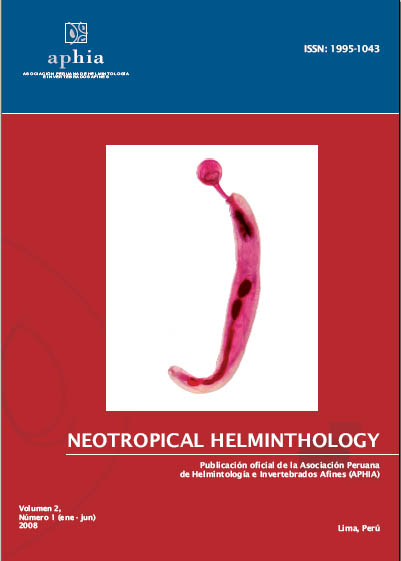ECOLOGICAL ASPECTS OF METAZOAN PARASITES OF CALLICHIRUS SEILACHERI (BOTT 1955) (DECAPODA, CALLIANASSIDAE) FROM LIMA, PERU
DOI:
https://doi.org/10.24039/rnh2008211129Keywords:
Callichirus seilacheri, Clausidium, Cestoda, Prochristianella hispida, Parasite ecology, Peru.Abstract
Quantitative aspects of parasite communities of marine macrozoobenthonic crabs, as burrowing shrimp
Callichirus seilacheri (Bott 1955) was not registered in South Pacific and Peru. For this reason, influence of size and sex of C. seilacheri, and evaluated period on its metazoan parasites was analyzed. Between November 1996 and January 2008, 1044 C. seilacheri acquired from Chorrillos, Lima, Peru, and necropsied to study their metazoan parasite. Of the burrowing shrimp collected, 571 were males and 473 females. Total length host mean was 10.62 ± 2.91 cm. Metazoan parasites were collected and registered employing standard procedures. Outer body surface, gill chamber, hemocoel, gut and hepatopancreas were examined. None parasite have three hundred forty and seven hosts. Showed infection with 1 parasite species, five hundred fifty and two hosts (52.9%), and with 2 parasite species forty-five had an infection (13.9%). Seven thousand seven hundred and fifty specimens in total during all the survey, with a mean abundance of 4.15 (1-67) were collected. The mean parasite species richness was 0.81 (1-2). Two parasites: Prochristianella hispida (Linton, 1890)(Cestoda) (hepatopancreas; prevalence = 32.8%; mean abundance = 0.92) and Clausidium vancouverense (Haddon, 1912) (Copepoda) (outer body surface and gill chamber; prevalence = 51.6%; mean abundance = 3.61) were survey. Abundance of infection of Parachristianella sp. and Clausidium vancouverense showed relation with size of C. seilacheri. Absence of association of size host with prevalence of infection of both parasites was found. Host sex only was found in dependence with prevalence of C. vancouverense. Prevalence and abundance of infection for both parasites showed variation during all period evaluated.
Downloads
Published
How to Cite
Issue
Section
License

This work is licensed under a Creative Commons Attribution-NonCommercial-NoDerivatives 4.0 International License.
OBJETO: El AUTOR-CEDENTE transfiere de manera TOTAL Y SIN LIMITACIÓN alguna al CESIONARIO los derechos patrimoniales que le corresponden sobre la (s) obra(s) tituladas: xxxxxxxxxxxxxxxx, por el tiempo que establezca la ley internacional. En virtud de lo anterior, se entiende que el CESIONARIO adquiere el derecho de reproducción en todas sus modalidades, incluso para inclusión audiovisual; el derecho de transformación o adaptación, comunicación pública, traducción, distribución y, en general, cualquier tipo de explotación que de las obras se pueda realizar por cualquier medio conocido o por conocer en el territorio nacional o internacional.
REMUNERACIÓN: La cesión de los derechos patrimoniales de autor que mediante este contrato se hace será a título gratuito.
CONDICIONES Y LEGITIMIDAD DE LOS DERECHOS: El AUTOR-CEDENTE garantiza que es propietario integral de los derechos de explotación de la(s) obra(s) y en consecuencia garantiza que puede contratar y transferir los derechos aquí cedidos sin ningún tipo de limitación por no tener ningún tipo de gravamen, limitación o disposición. En todo caso, responderá por cualquier reclamo que en materia de derecho de autor se pueda presentar, exonerando de cualquier responsabilidad al CESIONARIO.
LICENCIA DE ACCESO ABIERTO: El AUTOR-CEDENTE autoriza que manuscrito publicado en La Revista Neotropical Helminthology permanece disponible para su consulta pública en el sitio web https://www.neotropicalhelminthology.com/ y en los diferentes sistemas de indexación y bases de datos en las que la revista tiene visibilidad, bajo la licencia Creative Commons, en la modalidad Reconocimiento-No comercial- Sin Trabajos derivados –aprobada en Perú, y por lo tanto son de acceso abierto. De ahí que los autores dan, sin derecho a retribución económica, a la Asociación Peruana de Helmintología e Invertebrados Afines (APHIA), los derechos de autor para la edición y reproducción a través de diferentes medios de difusión.


 Numero 2 Volumen 19 - 2025 (versión Anticipada)
Numero 2 Volumen 19 - 2025 (versión Anticipada)














































